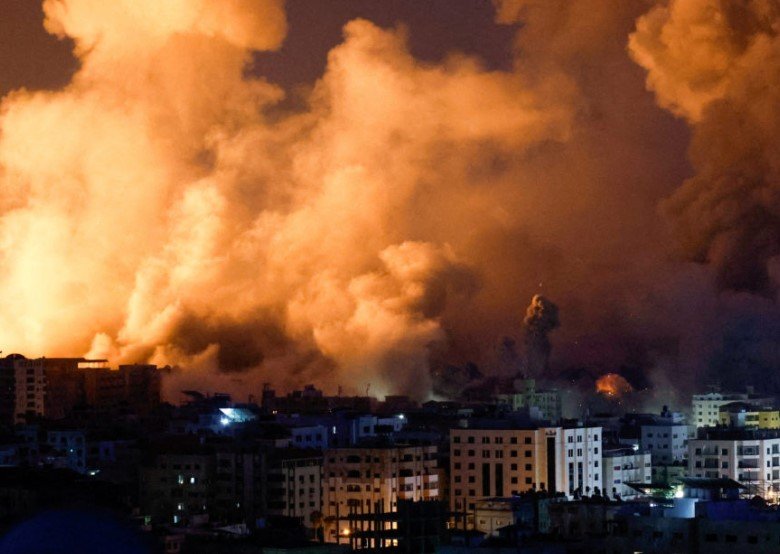Israeli forces launched deadly strikes in Gaza on Sunday, killing at least 24 Palestinians, just hours before planned indirect talks in Egypt aimed at advancing a ceasefire under President Donald Trump’s plan. The violence unfolded as delegations from Israel and Hamas prepared to discuss hostage releases and a potential end to the nearly two-year conflict, with Trump urging all sides to act swiftly.
Ongoing Strikes Amid Ceasefire Hopes
Fresh Israeli airstrikes hit multiple areas in Gaza, including central and southern regions, despite calls from the U.S. to halt the bombing. Medical sources reported that the attacks targeted civilian zones, with four people killed near an aid center in Rafah.
The strikes come at a tense moment, as both sides signal willingness to negotiate. Hamas confirmed its team, led by senior figure Khalil al-Hayya, arrived in Sharm el-Sheikh for the talks. Israel’s delegation, headed by top official Ron Dermer, is set to join on Monday.
Palestinian health officials noted a rise in casualties over the weekend, adding to the conflict’s toll that has claimed tens of thousands of lives since it began. Witnesses described heavy smoke and explosions in Gaza City, where ground operations have intensified.

Details of Trump’s Ceasefire Proposal
President Trump has pushed a 20-point plan to resolve the Gaza crisis, focusing on a hostage-prisoner swap and Israeli troop withdrawal. The initiative includes deploying Arab forces from Egypt, Jordan, and Saudi Arabia to secure the area until a local Palestinian authority takes over.
Key elements of the plan emphasize:
- Immediate ceasefire within weeks.
- Release of all remaining Israeli hostages.
- Exile of Hamas leaders and disarmament of militants.
- Reconstruction efforts backed by international aid.
Trump described the talks as progressing rapidly, posting on social media that technical teams would finalize details soon. He warned Hamas of severe consequences if they reject the deal, stressing the need for quick action to end the suffering.
Analysts say the plan builds on earlier Abraham Accords, aiming to involve more Arab states in Gaza’s governance. Netanyahu has voiced optimism, calling it a chance to secure Israel’s borders while freeing captives.
Recent events, like Syria’s post-Assad elections, have shifted regional dynamics, potentially aiding the negotiations. Trump’s team, including son-in-law Jared Kushner and envoy Steve Witkoff, is actively involved in the Egypt meetings.
Challenges and Reactions from Both Sides
Hamas has shown openness to parts of the plan but insists on a full Israeli withdrawal and guarantees for Palestinian rights. Their statement highlighted the need for prisoner exchanges, including thousands of Palestinians held in Israeli jails.
Israel maintains that any deal must ensure Hamas cannot regroup as a military threat. Prime Minister Benjamin Netanyahu stated on Friday that a hostage release could happen this week, but military actions would continue until security goals are met.
International observers worry that ongoing strikes could derail the talks. The U.N. has called for an immediate halt to violence to allow humanitarian access, as Gaza faces severe shortages of food and medicine.
Public sentiment in the region remains divided. Protests in Israel demand the return of hostages, while Palestinians in Gaza express exhaustion from the prolonged war.
| Aspect | Israeli Position | Hamas Position | U.S. Role |
|---|---|---|---|
| Ceasefire Timeline | Immediate but conditional on security | Full and permanent | Pushing for 60-day initial pause |
| Hostage/Prisoner Swap | Release of all captives first | Exchange for Palestinian prisoners | Mediating details |
| Troop Withdrawal | Phased, with buffers | Complete and immediate | Supports with Arab oversight |
| Governance | Arab-led interim force | Palestinian control | Backing reconstruction |
Global Implications and Next Steps
The Egypt talks represent a critical juncture, potentially leading to the first major breakthrough since the war escalated. Success could stabilize the Middle East, opening doors for broader peace efforts, including a two-state solution.
Failure risks further escalation, with Trump warning of “complete obliteration” for non-compliant parties. Regional powers like Qatar and Egypt are mediating, drawing on past ceasefire experiences.
Experts predict that if agreed upon, the plan could see initial hostage releases by mid-October, followed by aid influxes to rebuild Gaza’s infrastructure.
As the world watches, the human cost remains high. Families on both sides await news, hoping diplomacy prevails over continued conflict.
What do you think about the chances of this ceasefire holding? Share your thoughts in the comments and spread the word to keep the conversation going.
